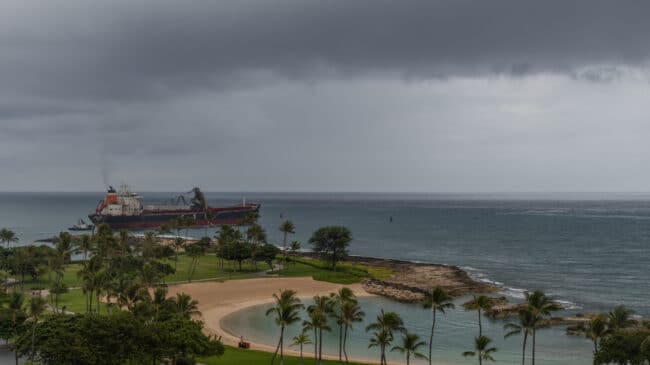The Jones Act, a century-old maritime law, has long been criticized for driving up shipping costs in noncontiguous U.S. states and territories. Now, a lawsuit from the Hawaii-based Kōloa Rum Company is arguing that the Jones Act unfairly disadvantages Hawaiian ports in violation of the Port Preference Clause of the Constitution. This promising legal approach to dismantling the act may have a chance of succeeding in court.
The Jones Act, enacted in 1920, requires that goods transported between U.S. ports use vessels built, owned, flagged, and crewed by Americans. While designed to support the domestic shipbuilding industry, the law’s main impact has been limiting international competition and raising shipping prices within the United States, particularly for islands or noncontiguous states and territories like Hawaii, Alaska, and Puerto Rico.
A recent lawsuit filed by the Hawaii-based Kōloa Rum Company, which is represented by the Pacific Legal Foundation, challenges the Jones Act on constitutional grounds. The plaintiff argues that the law violates the Port Preference Clause of Article I, Section 9 of the Constitution, which prohibits Congress from giving preferential treatment to one state’s ports over another’s. The lawsuit argues that the Jones Act favors mainland ports over Hawaiian ports, leading to higher shipping costs for Hawaiians, and is thus unconstitutional discrimination.
But what does the law say? The text of the Port Preference Clause states, “No Preference shall be given by any Regulation of Commerce or Revenue to the Ports of one State over those of another: nor shall Vessels bound to, or from, one State, be obliged to enter, clear, or pay Duties in another.”
The Port Preference Clause, as written, is extremely narrow—especially compared to widely litigated constitutional provisions such as the Commerce Clause. As a result, case law interpreting the precise legal meaning and application of the Port Preference Clause is limited.
The first related case under the Commerce Clause dates back to 1855, when a bridge that was being constructed over a section of the Ohio River in Virginia had low enough clearance to cause concern in Pennsylvania that it would keep steamboats from going upriver to Pittsburgh. Pennsylvania v. Wheeling & Belmont Bridge Co. went all the way to the Supreme Court, which ruled in favor of the bridge company, meaning the bridge provided sufficient clearance to vessels and thus didn’t violate the clause.
Sam Heavenrich, in a 2022 Yale Law Journal article, observed that Wheeling created two different interpretations of the Port Preference Clause. Heavenrich noted that under the narrow interpretation, the Port Preference Clause is all but nullified because the requirements for a statute to be unconstitutional under the clause would be hard to meet under any circumstances, requiring explicit discrimination against a state’s ports as a whole. For example, a law that says, verbatim, “Virginia’s ports shall be favored over that of Maryland’s” would fail a Ports Preference Clause test under the narrow interpretation.
Subsequent cases have leaned towards the narrow interpretation. However, Heavenrich contended that assuming this is the only interpretation is the wrong approach and that precedent for a broader interpretation that would prohibit legislation adopted with discriminatory intent was established in Wheeling.
The broader approach would acknowledge the intent of a bill or law and the explicit text of the laws. Heavenrich explains the legislative history of Sen. Wesley Livsey Jones of Washington state and the name behind the Jones Act. Sen. Jones had a history of protectionist bills that did target then-territories Hawaii and Alaska. So Heavenrich makes the case that, under a broad interpretation, the Jones Act would be unconstitutional under the Port Preference Clause.
Both interpretations, however, require a statute to authorize some form of explicit discrimination. In Justice Samuel Nelson’s majority opinion in Wheeling, the Supreme Court observed that many different statutes “may incidentally operate to the prejudice of the ports in a neighboring State [but] have never been supposed to conflict with [the Port Preference Clause].”
Put simply, the consequences on a port or a state’s port by statute are not a constitutional violation of the Port Preference Clause because it did not qualify as explicit discrimination per Justice Nelson’s interpretation. For example, a law like the Jones Act, while it may have consequences on shipping costs and the economy of Hawaii, that alone does not constitute a violation of the Port Preference Clause when interpreting the clause narrowly.
Heavenrich’s article makes a compelling case that this broader interpretation could lead to a successful challenge under the Port Preference Clause, especially when challenging the Jones Act.
A key component of the Kōloa Rum Company lawsuit is that the Jones Act’s impact on costs in Hawaii constitutes discrimination against the ports in Hawaii, so it’s essential to have a credible estimate for these costs. According to a 2020 Grassroot Institute of Hawaii study, which evaluated five different scenarios, the average citizen in Hawaii pays anywhere from $296 to $645 more on goods per year. The Grassroot Institute’s report estimated the Jones Act adds $0.40 to an average Hawaii family’s food bills, $1 to housing costs, and $0.14 to their electricity bills every day.
These costs are high because the Jones Act insulates U.S. shipping markets. Proponents of the Jones Act argue that the law protects national security and supports domestic employment. However, evidence indicates that the U.S. shipbuilding industry has struggled to remain competitive.
For example, the cost of building American ships is substantially higher than in other countries. Colin Grabow at the Cato Institute noted a natural case study highlighting these egregious cost differences. In 2022, three Aloha-class (the largest U.S.-built class of container ships) container ships were ordered from a Philadelphia shipyard for $333 million per ship. Two ships of the same class were ordered in 2013 for $209 million each, meaning that costs rose by over $100 million in just nine years.
For comparison, two container ships powered by liquid natural gas were ordered from a South Korean shipyard in 2022—the same year as the new orders from Philadelphia—and have more than double the cargo capacity of Aloha-class vessels. Each ship from the Korean shipyard costs $200 million less than the Aloha-class ships.
The Jones Act-compliant oceangoing fleet dropped from 434 ships in 1950 to 93 in 2023. Even with larger ships, the net carrying capacity has decreased and is lower today than in 1950.
The available data clearly shows that the Jones Act’s restrictions have raised shipping costs in noncontiguous states like Hawaii, validating the lawsuit’s claims of economic harm. Legally, there seems to be a path forward depending on whether the courts adopt the traditional narrow interpretation of the Port Preference Clause, but a challenge could succeed if the courts take a broader interpretation of what constitutes discrimination against a state’s ports.
Ultimately, the case presents an opportunity to update U.S. maritime policy to serve all Americans, especially those in noncontiguous and island states or territories like Hawaii, Alaska, and Puerto Rico, who bear the brunt of the harm caused by the Jones Act.

